1990 VOLVO 240 trailer
[x] Cancel search: trailerPage 2 of 143
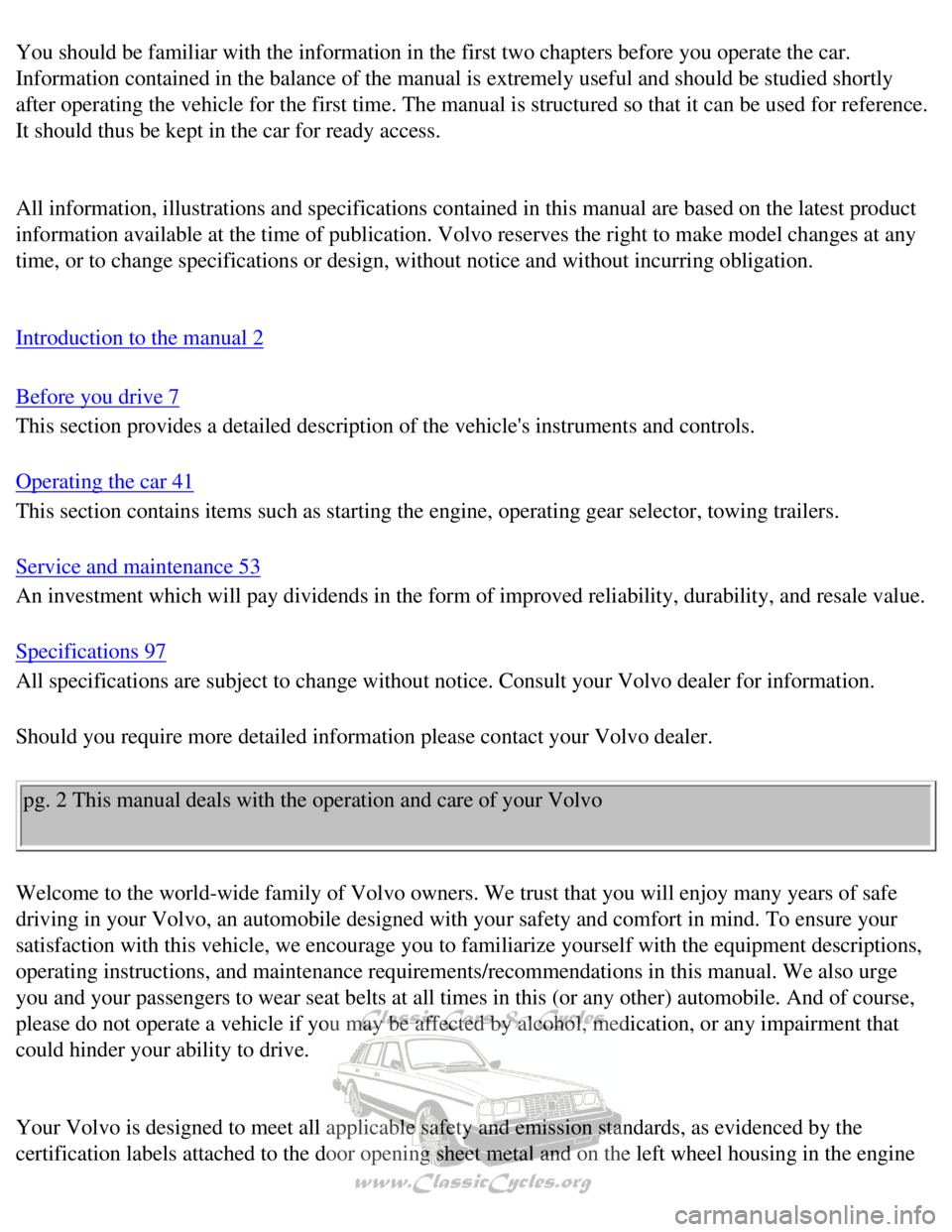
Volvo 1990 240 Model
You should be familiar with the information in the first two chapters be\
fore you operate the car.
Information contained in the balance of the manual is extremely useful a\
nd should be studied shortly
after operating the vehicle for the first time. The manual is structured\
so that it can be used for reference.
It should thus be kept in the car for ready access.
All information, illustrations and specifications contained in this manu\
al are based on the latest product
information available at the time of publication. Volvo reserves the rig\
ht to make model changes at any
time, or to change specifications or design, without notice and without \
incurring obligation.
Introduction to the manual 2
Before you drive 7
This section provides a detailed description of the vehicle's instrument\
s and controls.
Operating the car 41
This section contains items such as starting the engine, operating gear \
selector, towing trailers.
Service and maintenance 53
An investment which will pay dividends in the form of improved reliabili\
ty, durability, and resale value.
Specifications 97
All specifications are subject to change without notice. Consult your Vo\
lvo dealer for information.
Should you require more detailed information please contact your Volvo d\
ealer. pg. 2 This manual deals with the operation and care of your Volvo
Welcome to the world-wide family of Volvo owners. We trust that you will\
enjoy many years of safe
driving in your Volvo, an automobile designed with your safety and comfo\
rt in mind. To ensure your
satisfaction with this vehicle, we encourage you to familiarize yourself\
with the equipment descriptions,
operating instructions, and maintenance requirements/recommendations in \
this manual. We also urge
you and your passengers to wear seat belts at all times in this (or any\
other) automobile. And of course,
please do not operate a vehicle if you may be affected by alcohol, medic\
ation, or any impairment that
could hinder your ability to drive.
Your Volvo is designed to meet all applicable safety and emission standa\
rds, as evidenced by the
certification labels attached to the door opening sheet metal and on the\
left wheel housing in the engine
file:///K|/ownersdocs/1990/1990_240/90240_00.htm (2 of 4)12/30/2006 8:\
25:01 AM
Page 51 of 143

Volvo 1990 240 Model
pg. 41 Operating the car
42Service inspection
42Break-in period
43Driving economy, shift indicator light
44Starting the engine
45Manual transmission
46Automatic transmission
48Emergency towing
49Towing information
50Trailer hauling
51Automatic transmission, brake system
52Catalytic converter
pg. 42 Break-in period, Service inspection
A new car should be broken-in!
Manual transmission
During the break-in period do not exceed the following speeds*:
First 600 miles (1,000 km)
1st gear 20
mph
(30 km/h)
2nd
gear 30
mph
(50 km/h)
file:///K|/ownersdocs/1990/1990_240/90240_09.htm (1 of 6)12/30/2006 8:\
25:05 AM
Page 54 of 143

Volvo 1990 240 Model
l Avoid using automatic transmission kick-down feature unless necessary.
Other factors which decrease gas mileage are:
l Worn or dirty spark plugs
l Incorrect spark plug gap
l Dirty air filter
l Incorrect valve clearance
l Incorrect idle speed
l Dirty engine oil and clogged oil filter
l Dragging brakes
l Incorrect front end alignment
l Low tire pressure
Shift indicator light
(manual transmission models only)
The Volvo shift indicator light (S.I.L.) is a device designed to help \
you get even better gas mileage from
your Volvo car. Studies have shown that the best fuel economy is obtaine\
d by shifting gears at low
engine rpm and high relative engine load. The Volvo S.I.L. is calibrated\
to show you when to shift for
improved mileage without sacrificing smooth acceleration .
Use of the S.I.L. is simple. Shift to next higher gear as soon as the li\
ght comes on. You may find after
using the S.I.L. for some time that your natural shifting rhythm will ad\
apt to the S.I.L.'s suggestion.
Some drivers may even shift before the light comes on.
Obviously, there will be times when you need to shift later than the lig\
ht would indicate (for example,
when climbing hills or trailer towing). Using the light regularly, howe\
ver, should result in a mileage
improvement of six percent or more, depending on how you normally drive.\
Programming instructions for shift indicator
If the current supply to the control unit is cut (battery disconnected)\
, the control unit will have to be re-
programmed as the control unit memory will be erased.
Drive the car in each gear (first gear not necessary) for approximatel\
y 8 seconds.
The gear change indicator light will flicker once (0.5 seconds), as ea\
ch gear is programmed.
file:///K|/ownersdocs/1990/1990_240/90240_09.htm (4 of 6)12/30/2006 8:\
25:05 AM
Page 60 of 143
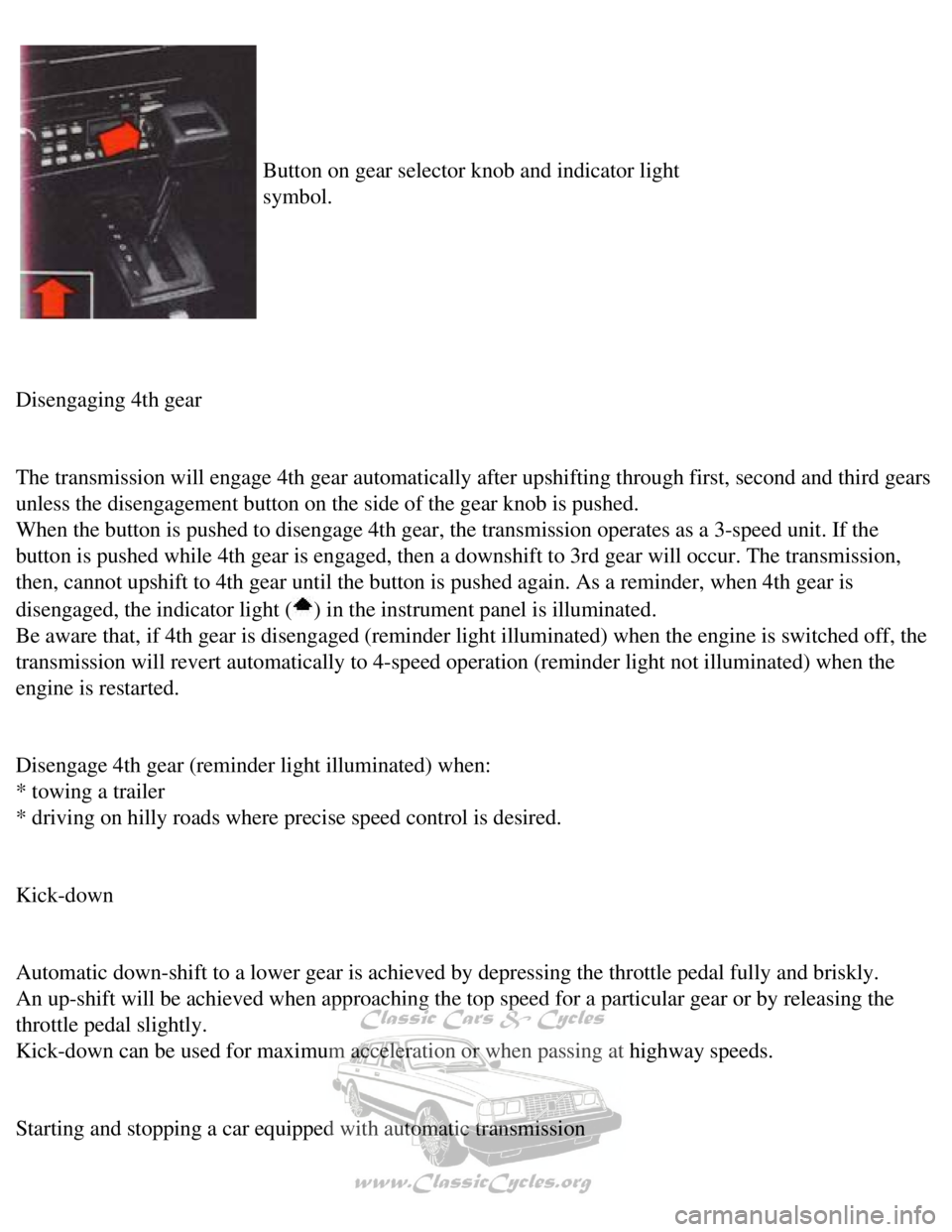
Volvo 1990 240 Model
Button on gear selector knob and indicator light
symbol.
Disengaging 4th gear
The transmission will engage 4th gear automatically after upshifting thr\
ough first, second and third gears
unless the disengagement button on the side of the gear knob is pushed. \
When the button is pushed to disengage 4th gear, the transmission operat\
es as a 3-speed unit. If the
button is pushed while 4th gear is engaged, then a downshift to 3rd gear\
will occur. The transmission,
then, cannot upshift to 4th gear until the button is pushed again. As a \
reminder, when 4th gear is
disengaged, the indicator light (
) in the instrument panel is illuminated.
Be aware that, if 4th gear is disengaged (reminder light illuminated) \
when the engine is switched off, the
transmission will revert automatically to 4-speed operation (reminder l\
ight not illuminated) when the
engine is restarted.
Disengage 4th gear (reminder light illuminated) when:
* towing a trailer
* driving on hilly roads where precise speed control is desired.
Kick-down
Automatic down-shift to a lower gear is achieved by depressing the throt\
tle pedal fully and briskly.
An up-shift will be achieved when approaching the top speed for a partic\
ular gear or by releasing the
throttle pedal slightly.
Kick-down can be used for maximum acceleration or when passing at highwa\
y speeds.
Starting and stopping a car equipped with automatic transmission
file:///K|/ownersdocs/1990/1990_240/90240_10.htm (4 of 7)12/30/2006 8:\
25:05 AM
Page 64 of 143
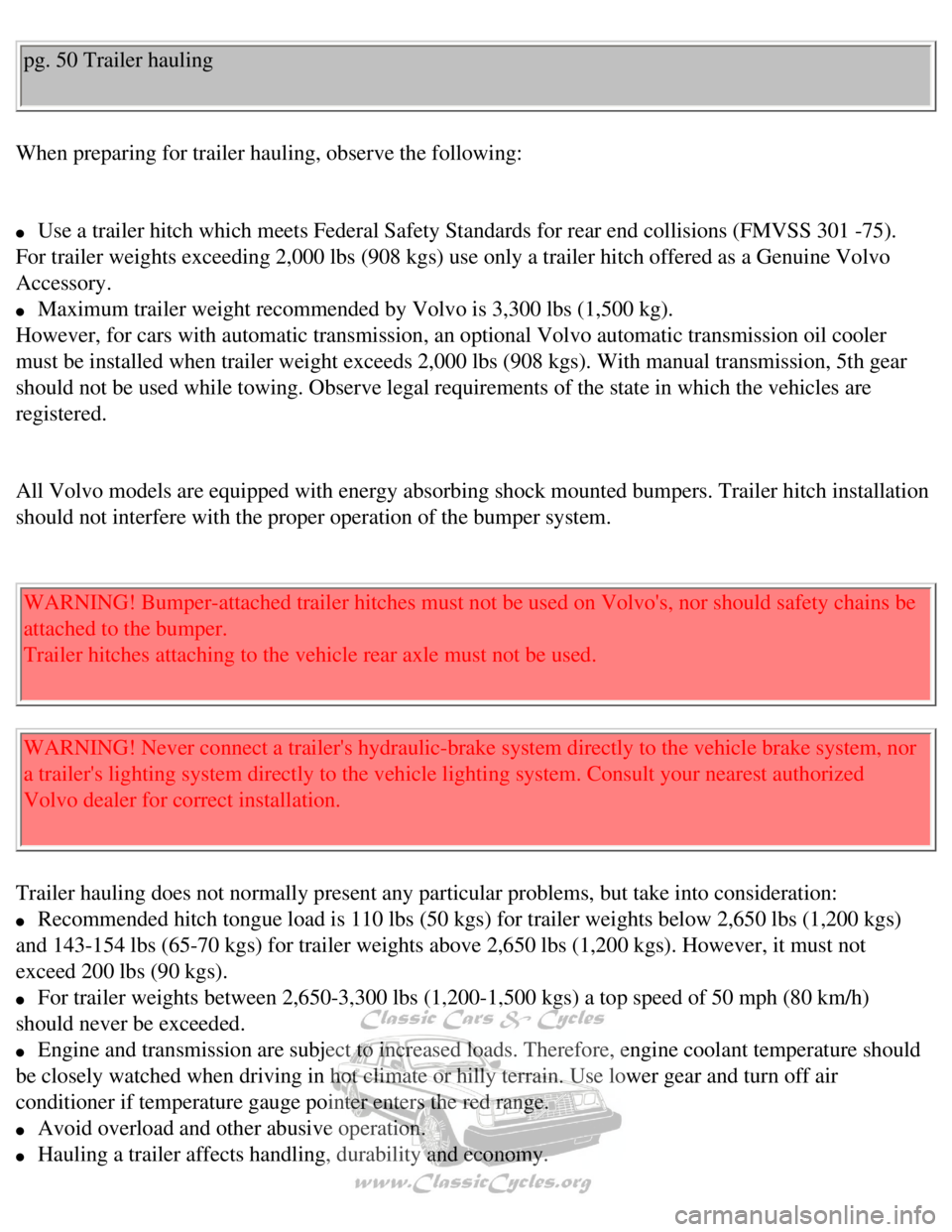
Volvo 1990 240 Model
pg. 50 Trailer hauling
When preparing for trailer hauling, observe the following:
l Use a trailer hitch which meets Federal Safety Standards for rear end co\
llisions (FMVSS 301 -75).
For trailer weights exceeding 2,000 lbs (908 kgs) use only a trailer h\
itch offered as a Genuine Volvo
Accessory.
l Maximum trailer weight recommended by Volvo is 3,300 lbs (1,500 kg). \
However, for cars with automatic transmission, an optional Volvo automat\
ic transmission oil cooler
must be installed when trailer weight exceeds 2,000 lbs (908 kgs). Wit\
h manual transmission, 5th gear
should not be used while towing. Observe legal requirements of the state\
in which the vehicles are
registered.
All Volvo models are equipped with energy absorbing shock mounted bumper\
s. Trailer hitch installation
should not interfere with the proper operation of the bumper system.
WARNING! Bumper-attached trailer hitches must not be used on Volvo's, no\
r should safety chains be
attached to the bumper.
Trailer hitches attaching to the vehicle rear axle must not be used.
WARNING! Never connect a trailer's hydraulic-brake system directly to th\
e vehicle brake system, nor
a trailer's lighting system directly to the vehicle lighting system. Con\
sult your nearest authorized
Volvo dealer for correct installation.
Trailer hauling does not normally present any particular problems, but t\
ake into consideration:
l Recommended hitch tongue load is 110 lbs (50 kgs) for trailer weights \
below 2,650 lbs (1,200 kgs)
and 143-154 lbs (65-70 kgs) for trailer weights above 2,650 lbs (1,20\
0 kgs). However, it must not
exceed 200 lbs (90 kgs).
l For trailer weights between 2,650-3,300 lbs (1,200-1,500 kgs) a top sp\
eed of 50 mph (80 km/h)
should never be exceeded.
l Engine and transmission are subject to increased loads. Therefore, engin\
e coolant temperature should
be closely watched when driving in hot climate or hilly terrain. Use low\
er gear and turn off air
conditioner if temperature gauge pointer enters the red range.
l Avoid overload and other abusive operation.
l Hauling a trailer affects handling, durability and economy.
file:///K|/ownersdocs/1990/1990_240/90240_11.htm (1 of 6)12/30/2006 8:\
25:06 AM
Page 65 of 143
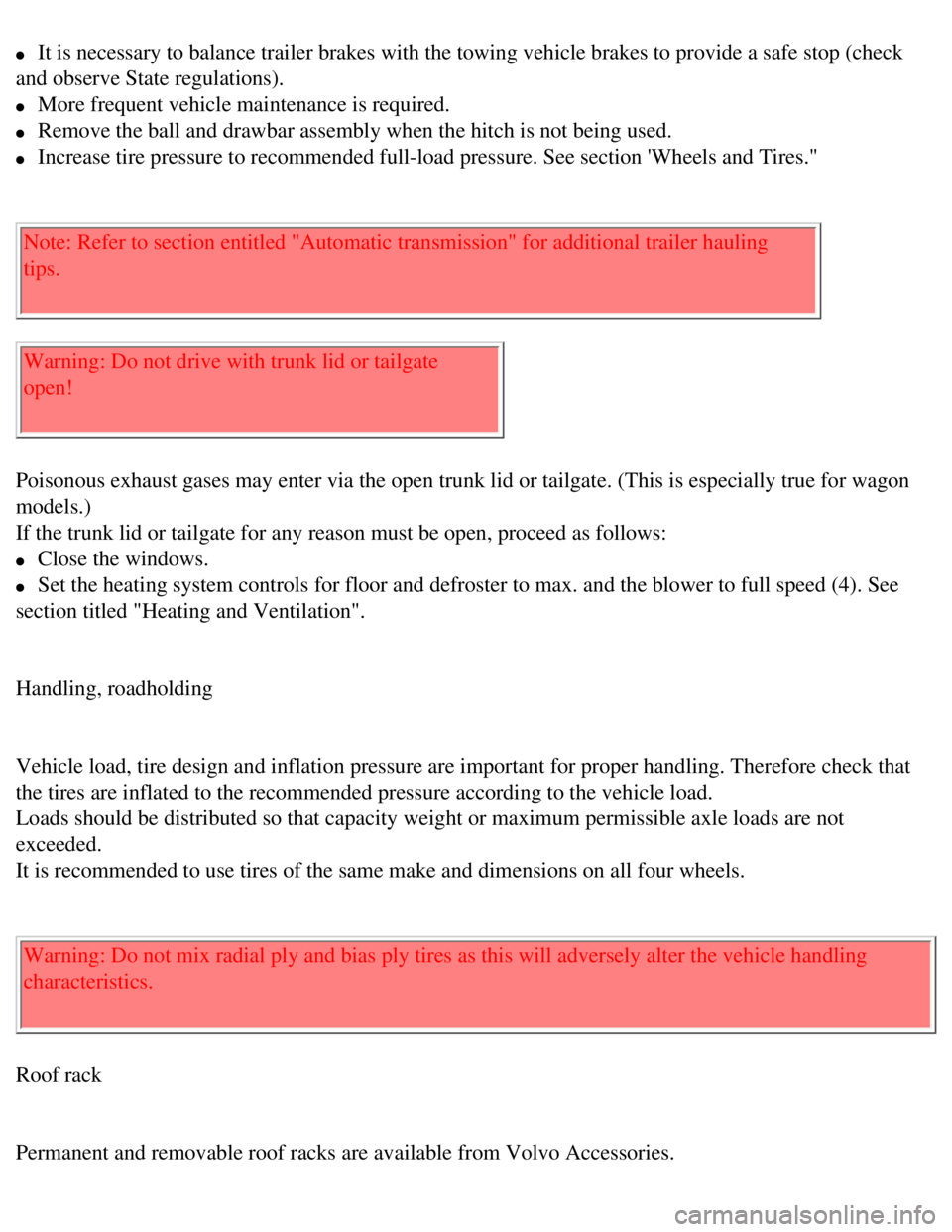
Volvo 1990 240 Model
l It is necessary to balance trailer brakes with the towing vehicle brakes\
to provide a safe stop (check
and observe State regulations).
l More frequent vehicle maintenance is required.
l Remove the ball and drawbar assembly when the hitch is not being used.
l Increase tire pressure to recommended full-load pressure. See section 'W\
heels and Tires."
Note: Refer to section entitled "Automatic transmission" for additional \
trailer hauling
tips.
Warning: Do not drive with trunk lid or tailgate
open!
Poisonous exhaust gases may enter via the open trunk lid or tailgate. (\
This is especially true for wagon
models.)
If the trunk lid or tailgate for any reason must be open, proceed as fol\
lows:
l Close the windows.
l Set the heating system controls for floor and defroster to max. and the \
blower to full speed (4). See
section titled "Heating and Ventilation".
Handling, roadholding
Vehicle load, tire design and inflation pressure are important for prope\
r handling. Therefore check that
the tires are inflated to the recommended pressure according to the vehi\
cle load.
Loads should be distributed so that capacity weight or maximum permissib\
le axle loads are not
exceeded.
It is recommended to use tires of the same make and dimensions on all fo\
ur wheels.
Warning: Do not mix radial ply and bias ply tires as this will adversely\
alter the vehicle handling
characteristics.
Roof rack
Permanent and removable roof racks are available from Volvo Accessories.\
file:///K|/ownersdocs/1990/1990_240/90240_11.htm (2 of 6)12/30/2006 8:\
25:06 AM
Page 66 of 143
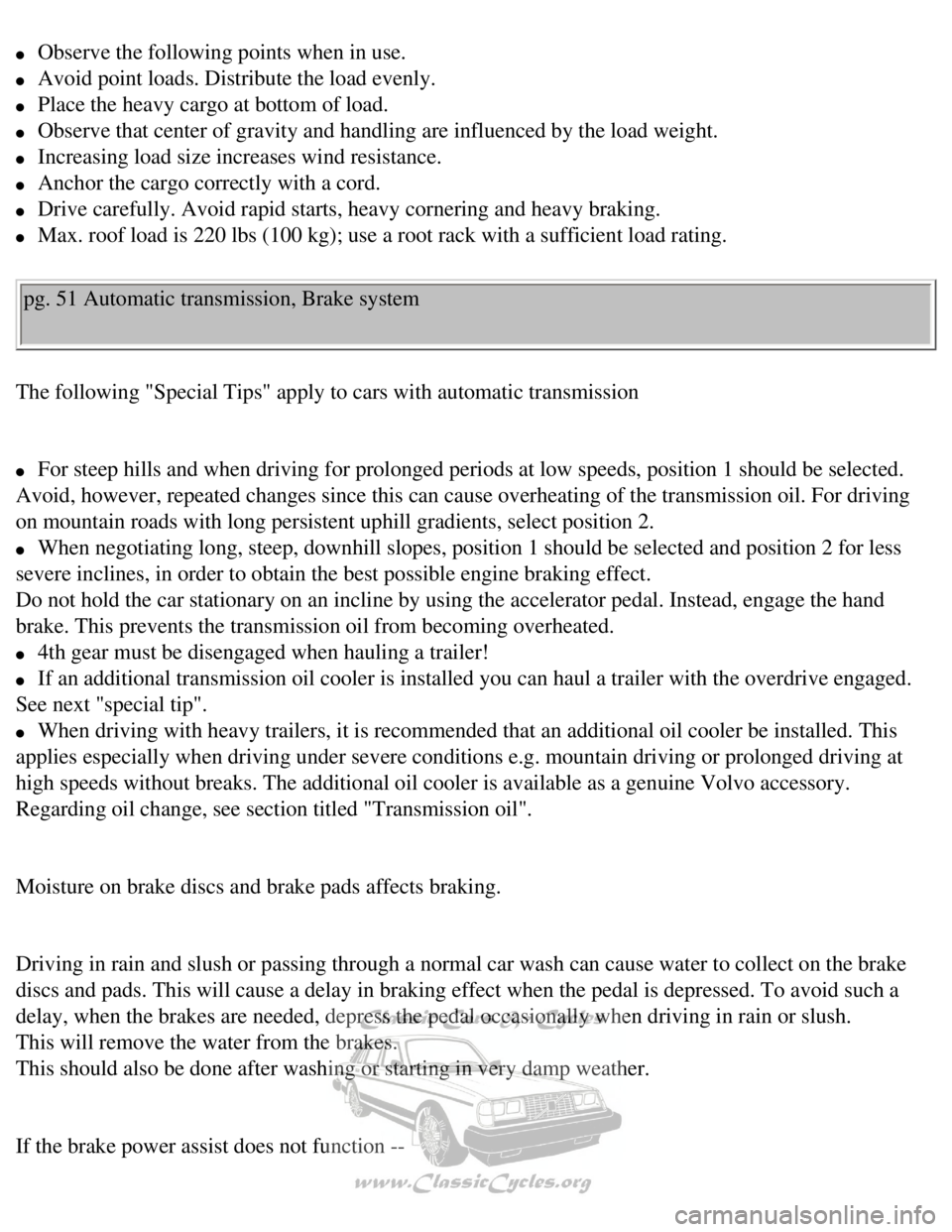
Volvo 1990 240 Model
l Observe the following points when in use.
l Avoid point loads. Distribute the load evenly.
l Place the heavy cargo at bottom of load.
l Observe that center of gravity and handling are influenced by the load w\
eight.
l Increasing load size increases wind resistance.
l Anchor the cargo correctly with a cord.
l Drive carefully. Avoid rapid starts, heavy cornering and heavy braking. \
l Max. roof load is 220 lbs (100 kg); use a root rack with a sufficient \
load rating.
pg. 51 Automatic transmission, Brake system
The following "Special Tips" apply to cars with automatic transmission
l For steep hills and when driving for prolonged periods at low speeds, po\
sition 1 should be selected.
Avoid, however, repeated changes since this can cause overheating of the\
transmission oil. For driving
on mountain roads with long persistent uphill gradients, select position\
2.
l When negotiating long, steep, downhill slopes, position 1 should be sele\
cted and position 2 for less
severe inclines, in order to obtain the best possible engine braking eff\
ect.
Do not hold the car stationary on an incline by using the accelerator pe\
dal. Instead, engage the hand
brake. This prevents the transmission oil from becoming overheated.
l 4th gear must be disengaged when hauling a trailer!
l If an additional transmission oil cooler is installed you can haul a tra\
iler with the overdrive engaged.
See next "special tip".
l When driving with heavy trailers, it is recommended that an additional o\
il cooler be installed. This
applies especially when driving under severe conditions e.g. mountain dr\
iving or prolonged driving at
high speeds without breaks. The additional oil cooler is available as a \
genuine Volvo accessory.
Regarding oil change, see section titled "Transmission oil".
Moisture on brake discs and brake pads affects braking.
Driving in rain and slush or passing through a normal car wash can cause\
water to collect on the brake
discs and pads. This will cause a delay in braking effect when the pedal\
is depressed. To avoid such a
delay, when the brakes are needed, depress the pedal occasionally when d\
riving in rain or slush.
This will remove the water from the brakes.
This should also be done after washing or starting in very damp weather.\
If the brake power assist does not function --
file:///K|/ownersdocs/1990/1990_240/90240_11.htm (3 of 6)12/30/2006 8:\
25:06 AM
Page 82 of 143
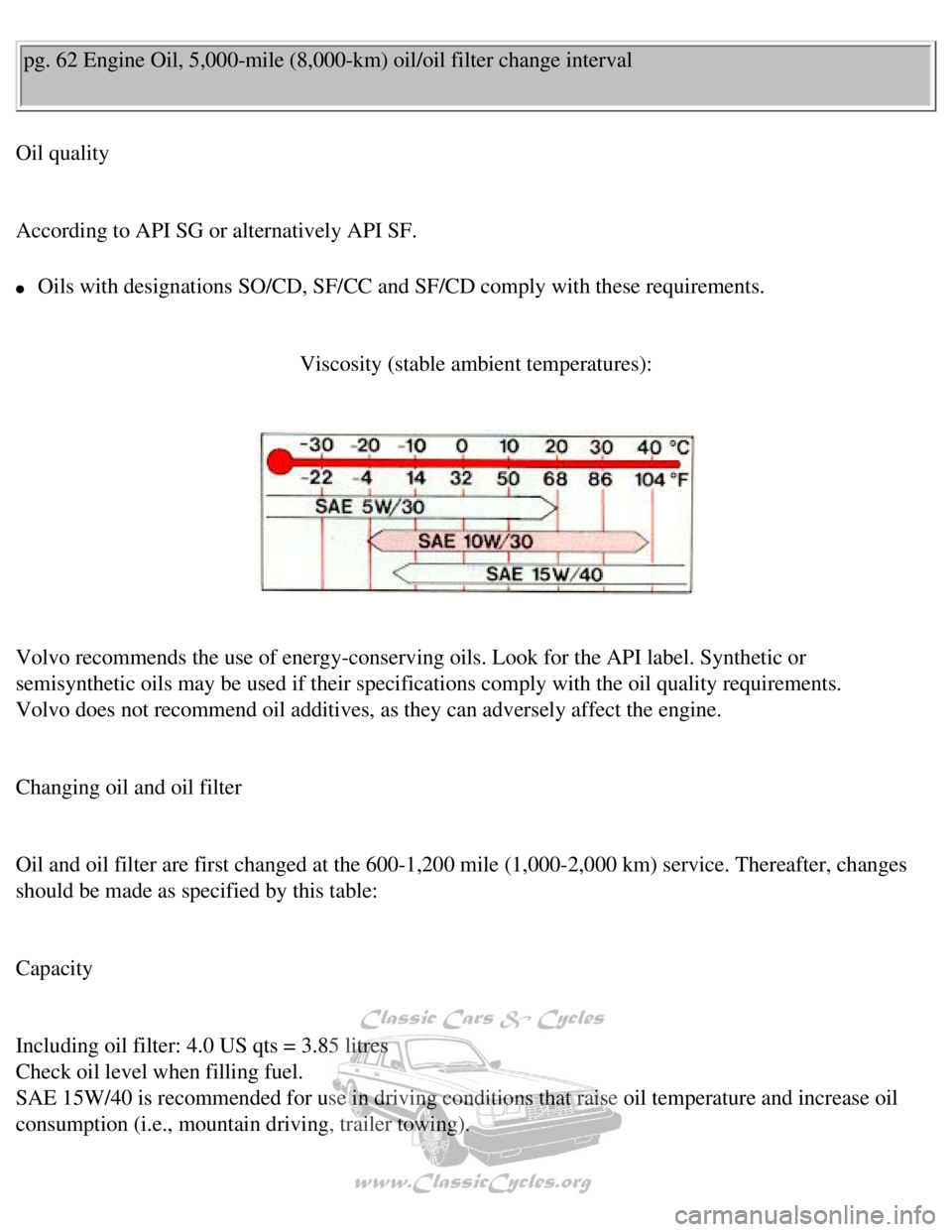
Volvo 1990 240 Model
pg. 62 Engine Oil, 5,000-mile (8,000-km) oil/oil filter change interva\
l
Oil quality
According to API SG or alternatively API SF.
l Oils with designations SO/CD, SF/CC and SF/CD comply with these requirem\
ents.
Viscosity (stable ambient temperatures):
Volvo recommends the use of energy-conserving oils. Look for the API lab\
el. Synthetic or
semisynthetic oils may be used if their specifications comply with the o\
il quality requirements.
Volvo does not recommend oil additives, as they can adversely affect the\
engine.
Changing oil and oil filter
Oil and oil filter are first changed at the 600-1,200 mile (1,000-2,000\
km) service. Thereafter, changes
should be made as specified by this table:
Capacity
Including oil filter: 4.0 US qts = 3.85 litres
Check oil level when filling fuel.
SAE 15W/40 is recommended for use in driving conditions that raise oil t\
emperature and increase oil
consumption (i.e., mountain driving, trailer towing).
file:///K|/ownersdocs/1990/1990_240/90240_13.htm (6 of 9)12/30/2006 8:\
25:08 AM